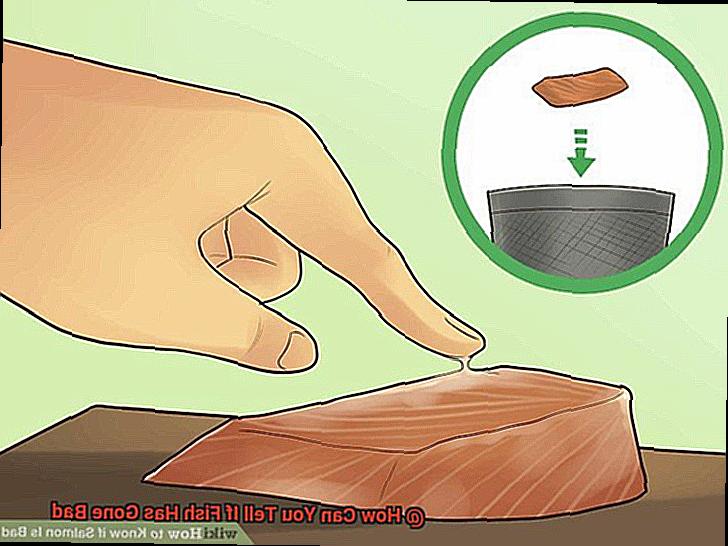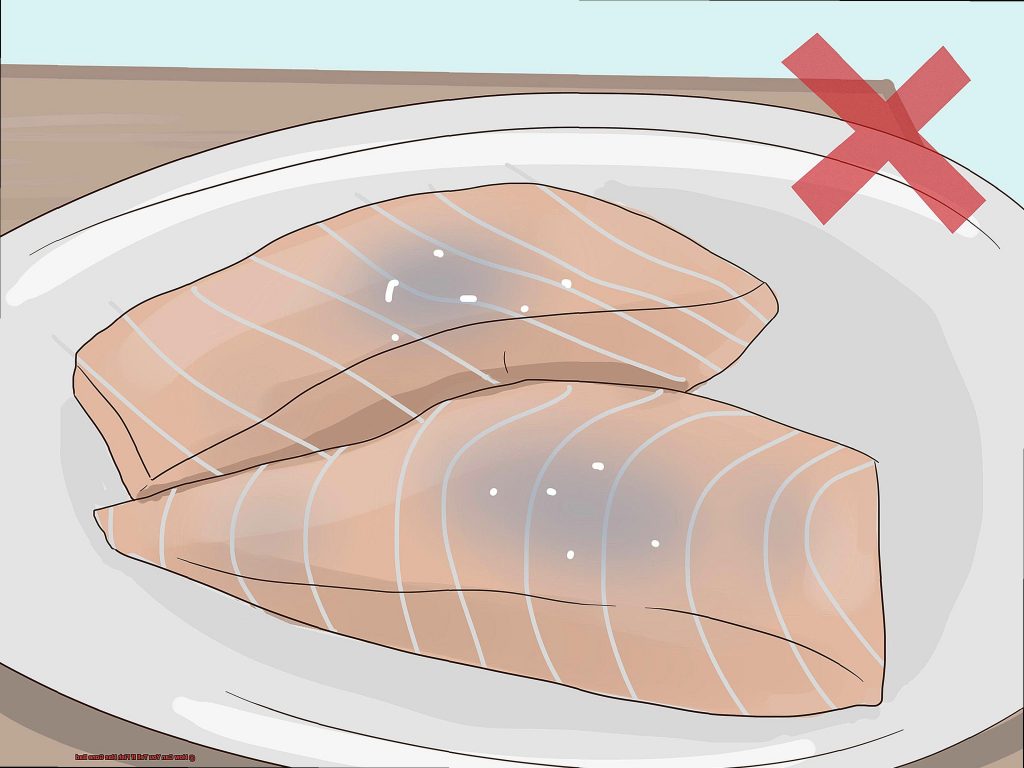The tantalizing taste of perfectly cooked fish. Whether it’s flaky salmon, succulent shrimp, or tender tuna, seafood has a magical way of whisking our taste buds away to the depths of oceanic bliss. But let’s face it – there’s always that niggling worry in the back of our minds: how can we tell if our beloved fish has gone bad?
Picture this: you indulge in a mouthwatering fish feast, only to wake up the next day with a rebellious stomach. It’s a culinary nightmare, my friends. But fret not. Today, we embark on an enlightening journey to unravel the secrets of deciphering whether our prized catch has passed its prime.
Are you ready to become skilled fish detectives? Grab your aprons, sharpen those senses, and prepare for an adventure like no other. Join me as we uncover the telltale signs that expose spoiled seafood lurking within your fridge.
In this delectable guide, we’ll explore visual cues, olfactory hints, and even tactile sensations that reveal a fish’s true state. From slimy textures and off-putting odors to discolored flesh and faded eyes – each sign becomes a breadcrumb guiding us towards fish righteousness.

Whether you’re a seasoned pescatarian or an adventurous foodie eager to expand your culinary horizons, the insights shared within this article will arm you with invaluable knowledge for future encounters with our underwater friends. So come along as we dive headfirst into the fascinating world of spoiled seafood, empowering ourselves to savor fish dishes with confidence and unrivaled gustatory pleasure.
Stay tuned. Our journey begins by exploring the visual aspects that hold the key to unraveling the mysteries of rotten fish. Get ready to be amazed.
Contents
What is the Smell Test?
Have you ever opened a package of fish and immediately recoiled from the strong, unpleasant odor? That’s your nose telling you that the fish has gone bad. But what exactly is the Smell Test and how can it help ensure that the fish you consume is safe and fresh? In this article, we’ll dive deeper into this simple yet reliable method and explore other clues to look out for when determining fish freshness.
The Power of Your Sense of Smell:
Our noses are remarkable tools in detecting spoilage in fish. Fresh fish should greet you with a mild, briny scent reminiscent of the ocean, thanks to natural compounds present in its flesh. However, if the fish emits an overpowering fishy or ammonia-like odor, it’s a clear indication that it has spoiled.
Texture and Color Clues:
While the Smell Test is a dependable indicator, there are other signs to consider. Fresh fish should have firm flesh and a shiny appearance. If the texture feels soft or slimy, it may have started to spoil. Additionally, vibrant and translucent flesh indicates freshness, while dull or discolored flesh should be avoided.
Visible Signs of Spoilage:
Spoiled fish may sometimes exhibit visible signs of mold or other growths. Any such growths are immediate red flags that the fish is no longer safe to eat. Proper storage and handling practices are crucial in preventing these visible signs of spoilage.
The Poke Test:

Another trustworthy method is the “poke test.” Gently press a fork or your finger into the flesh of the fish. Fresh fish will spring back quickly, leaving no indentation. If an indentation remains or the flesh feels mushy, it’s a clear sign that the fish is no longer fresh.
Trusting Your Instincts:
Ultimately, trust your instincts when it comes to determining fish freshness. Our senses are powerful tools, and if something seems off or you have doubts about the fish’s freshness, it’s better to err on the side of caution and discard it.
What is the Texture Test?
We’ve all experienced the disappointment of biting into a spoiled piece of fish. But fear not, because today we’re delving into the world of the Texture Test – a simple yet powerful method to determine if your fish is still fresh and safe to devour. So grab your apron and embark on this sensory adventure with us.
The Touch of Freshness: Firm and Resilient
When it comes to assessing fish texture, firmness is the key. A touch of your finger should reveal a fish that feels robust and resilient. Give it a gentle poke – if it springs back gracefully, you’re off to a promising start on your culinary journey.
The Slippery Slope: A Slimy Situation
Now, let’s navigate through the treacherous waters of sliminess. If your fish feels unnervingly slippery, then bid it farewell. A slimy coating on the surface is an unmistakable sign that bacterial growth has conquered your catch of the day. Remember, fresh fish should exude cleanliness and smoothness, not mimic the slippery glide of an eel.
The Discoloration Dilemma: Spots That Raise Concern
Keep a vigilant eye out for any white or brown spots adorning your fish. Fresh fish should boast a clean, translucent appearance that invites culinary exploration. Any discoloration encountered is an urgent red flag demanding attention. These spots are usually the result of bacterial growth or oxidation, indicating that your fish’s prime time has come to an end.
The Power of Scents: What Your Nose Knows
While we indulge in the realm of textures, let us not overlook the olfactory experience. Fresh fish should unleash a gentle, briny aroma reminiscent of oceanic delights. However, if a whiff delivers an ammonia-like or rotten fragrance, it’s time to bid adieu to that fillet. A pungent odor often serves as an unequivocal sign that your fish has succumbed to spoilage.
What is the Color Test?
Prepare to embark on a thrilling expedition into the world of fish freshness. Today, we plunge into the captivating realm of the Color Test, a simple yet potent method that empowers you to determine the quality of your fish. Grab your snorkel and get ready for an underwater adventure like no other.
The Basics of the Color Test:
Imagine yourself at a bustling fish market, eyes darting across a sea of shimmering scales and resplendent skins. But how can you discern if that fish is fresh or teetering on the edge of spoilage? Fear not, for the Color Test is your trusted companion in this culinary quest.
Step 1: Decoding the Skin:
A fish’s skin holds the secrets to its freshness. Look for lustrous, metallic skin adorned with shades of silver, pink, or red, depending on the species. Dullness or a tinge of grayish hue should trigger caution bells. This could be a telltale sign that the fish has passed its prime.
Step 2: Unveiling the Flesh:
Now, let’s turn our attention to the flesh itself. A fresh catch should boast firm and moist flesh with a pristine, translucent appearance. Any discoloration, whether it be yellowing or browning, sends out warning flares. Remember, we seek that vibrant and lively look. If the flesh feels tacky or slimy to the touch, it’s time to bid adieu.
Special Considerations:
Ahoy there. Before we dive deeper, let’s address an important point. Some fish species naturally sport darker flesh, like our dear friends tuna and salmon. But fret not. In these cases, a darker hue doesn’t necessarily signify spoilage. However, be cautious if there’s a notable departure from the typical coloration for that particular species.
Why Trust the Color Test?
The Color Test isn’t a mere fisherman’s folklore. It stands firmly on the foundation of science and experience. Spoiled fish often undergo chemical reactions and bacterial growth, resulting in changes in color. By keenly observing these visual cues, you can ensure that only the freshest and safest seafood graces your plate.
Visible Signs of Spoilage
The tantalizing world of fish freshness. In our previous section, we delved into the mesmerizing Color Test, a tool to unveil your catch’s quality. But what if your fish fails this vibrant test? Fear not, fellow seafood enthusiasts. Today, I shall be your devoted expert companion as we plunge into the captivating realm of visible signs of spoilage in fish. Together, we shall uncover the secrets that will shield you from consuming anything but the freshest and most delectable fish on your plate.
The Color Kaleidoscope:
Fresh fish is a dazzling sight to behold, its flesh vibrant and translucent like a gem submerged in an underwater paradise. However, when spoilage strikes, the colors embark on a treacherous journey. Beware of dullness, discolored patches, or a sickly yellowish tint – these are undeniable signs that your fish has lost its luster.
Sliminess SOS:
A hint of slime never hurt anyone, right? Well, with fish, it all boils down to moderation. Fresh fish boasts a delicate layer of clear and slightly slimy mucus on its skin, a natural armor bestowed upon it by Mother Nature. Nonetheless, if you encounter copious amounts or an overwhelming thickness of slime coating your catch, unfurl the red flag of spoilage without hesitation.
Texture Tales:
Texture is where fresh fish reigns supreme – its flesh firm and elastic, an enchanting dance on your palate. Yet, brace yourself for a culinary nightmare if you encounter spoiled fish: a mushy consistency that slithers away from your taste buds or even a grainy texture that shatters your gustatory dreams. Rest assured, my friend, there is better fare awaiting you.
Sniffing Out Trouble:
Our sense of smell is an indomitable ally when it comes to unmasking spoiled fish. Fresh fish exudes a mild oceanic aroma, akin to a gentle sea breeze on a sun-kissed day. But should the pungent stench of ammonia or rotten eggs assail your nostrils, it is time to turn away and bid adieu to that particular piscine acquaintance.
Proper Storage and Handling Practices
In our last section, we explored the captivating world of visible signs that indicate spoiled fish. But what if I told you there’s a way to prevent fish from spoiling in the first place? That’s right, my friends. Today, we’re diving into the importance of proper storage and handling practices in maintaining the freshness and quality of our beloved fish.
Let’s start with the basics. Temperature is key. Fish, being highly perishable, must be stored at the correct temperature. Keep it below 40°F (4°C) to slow down bacterial growth. Refrigeration or ice will do the trick. And if you really want to extend its shelf life, freezing at 0°F (-18°C) or below is a game-changer.
Now, let’s talk about keeping things separate. Fish has a distinct odor that can easily transfer to other items in your fridge. To avoid cross-contamination, seal it in containers or wrap it tightly in plastic or foil. Trust me, you don’t want your fruit salad tasting like yesterday’s catch.
Speaking of freshness, timing is everything. Enjoy fish at its peak flavor by consuming it as soon as possible. But if you need to store it longer, freezing is your best friend. Before freezing, remove excess moisture by patting it dry with paper towels. Then, wrap it tightly in freezer-safe packaging and label it with the date for future reference.
Now, let’s thaw things out safely. The best method is overnight thawing in the refrigerator. But if you’re short on time, submerge it in cold water, changing every 30 minutes until fully thawed. Avoid room temperature thawing, as that’s a bacterial party waiting to happen.
But proper storage is only half the battle. Handling fish correctly is equally crucial. When purchasing, look for clear, bright eyes and shiny skin with vibrant colors. The flesh should be firm and spring back when touched. And remember, a strong fishy odor is a clear sign that it’s time to swim away.
During preparation, hygiene is key. Wash your hands thoroughly before and after handling fish to prevent cross-contamination. Use separate cutting boards and utensils to avoid contaminating other ingredients.
The Poke Test
Prepare to be amazed as we unravel the secrets of this ingenious technique that will ensure your fish is always fresh and delectable. So, without further ado, let’s dive right in.
The Poke Test, my friends, is like a sacred ritual between you and your fish. It’s a powerful tool that can unveil the hidden truth about its freshness. Once you have mastered this art, you’ll never have to worry about serving up spoiled seafood again. Get ready to become the ultimate fish connoisseur.
To perform the Poke Test, you’ll need either your trusty finger or a utensil of choice. Whether you prefer the personal touch of your finger or the precision of a utensil is entirely up to you. Channel your inner fish whisperer and let’s proceed.
Before we begin the poking extravaganza, take a moment to observe your fish. Fresh fish should boast smooth, glossy skin with eyes that sparkle like diamonds. The gills should be a vibrant shade of red or pink, devoid of any sliminess or unpleasant odors. Any signs of discoloration, pungent fishy smells, or decay are clear indications of a fish past its prime.
Now comes the thrilling part – the poking. Gently press your finger or utensil into the flesh of the fish, and pay attention to its response. Fresh fish will put up a firm resistance, bouncing back with pride and resilience. It’s as if they are saying, “I’m still at the peak of my freshness.” However, if your poke leaves behind an imprint or if the flesh feels soft and mushy, alas, your beloved fish has bid adieu to its prime days.
But hold on, there’s more to this captivating test. If you’re dealing with cooked or processed fish, bear in mind that the Poke Test may not be foolproof. The texture can vary depending on the cooking method used. In such cases, rely on your senses to detect any peculiar smells or tastes that could indicate spoilage. Trust your instincts, my fellow fish aficionados.
Trust Your Instincts
When it comes to savoring the freshest seafood, nothing beats trusting your instincts. While we’ve explored various methods to assess fish freshness, our intuition can often be a reliable guide. In this section, we will dive deep into the significance of relying on your instincts when determining if fish has gone bad. Get ready to sharpen your senses and unlock the secrets of becoming a fish connoisseur extraordinaire.
Sense of Smell:
Prepare to unleash the power of your nose in the pursuit of freshness. Our sense of smell is a formidable weapon when it comes to assessing the quality of fish. Trust your olfactory prowess and be on the lookout for any foul odors.
Fresh fish should exude a mild, briny scent reminiscent of the ocean’s embrace. But beware. Should you encounter an overpowering whiff of ammonia or rottenness, it’s an unmistakable signal that the fish has spoiled. Embrace your nose’s wisdom and don’t ignore any unpleasant aromas – they hold the key to preserving your palates.
Appearance and Texture:
The eyes are windows to the soul, and they reveal much about the freshness of fish. Seek out bright and clear eyes, slightly bulging with life – a telltale sign of its pristine condition. Be wary of dull, cloudy, or sunken eyes, as they may signify spoilage lurking beneath the surface.
The skin, too, holds valuable clues about fish freshness. A shiny and moist exterior is what you should seek, avoiding any hint of dryness or sliminess. Beware of any discolored patches like brown or yellow blemishes; they serve as warning signs of potential deterioration.
But let’s not forget about the gills – those delicate structures hidden within the fish’s depths. Bright red or pink gills, devoid of slime or mucus, are the epitome of freshness. Should you encounter grayish or brownish gills, accompanied by an excessive amount of slime, it’s a clear indication that the fish has outstayed its welcome.
Tr1KjDyNY6s” >
Conclusion
Determining if fish has spoiled is crucial for your health and enjoyment of a seafood dish.
To ensure you’re not consuming bad fish, it’s essential to rely on your senses and pay attention to certain signs. Trust your nose: if the fish emits a strong, unpleasant odor, it’s a clear indication that it’s gone bad.
Additionally, examine its appearance closely: if the flesh looks dull or discolored, or if there are slimy or moldy patches present, it’s best to steer clear. Texture matters too – if the fish feels excessively mushy or has a sticky film on its surface, it’s time to discard it.
Lastly, trust your taste buds: if the fish tastes off or has an unusual flavor, don’t take any chances.






